

Jesus
- Son of the Panther
and the Cult of Bacchus-Dionysus
by
Andrew Collins
As
early as the second century AD Jesus was said to have been the offspring of Mary
and a "soldier named Panthera," a claim made by Jews and repeated by
Origen, the Alexandrian scholar and Christian theologian (d. 254 CE). Then in
the fourth century Epiphanius of Salamis (d. 403 CE) in his Panarion, a treatise
against Christian heresies, recorded that Joseph, the husband of Mary and father
of Jesus, and his brother Cleopas were sons of "Jacob surnamed panther."
Jewish Talmadic texts of the fourth and fifth centuries also speak of "Jeschu,"
that is Jesus, being the son of "Pandira" or "Pandeira," in
other words the panther. Similar themes appear in the Jewish anti-Gospel known
as the Toledoth Jeschu, which dates to the twelfth century CE. Here Jesus is the
son of Mary and "Joseph Pandira."
Despite
attempts by scholars to show that the Pandira, Pandeira or Panther in question
was the epithet of a Roman soldier (see figure 1) whom Jews spoke of disparagingly
as the father of Jesus to show he was not of virgin birth, this does not explain
why he and male members of his family might have borne the title ben panthera,
"son of the panther." Clearly, some writer researchers have seen the
clear links between this title and the cult of the god Bacchus-Dionysus, who was
himself seen as a son of the panther. Indeed, a number of curious correlations
do exist between the recorded life and later Christian cult of Jesus and that
of Dionysus, and these have frequently been cited in popular books. Yet these
claims were made as early as 1836 in the Anacalypsis of Godfrey Higgins,
who saw the mystery rites of Dionysus as at the root of the Christos myth. In
his opinion Bacchus-Dionysus:
… was born of a virgin on the 25th of December; he performed great miracles for the good of mankind; particularly one in which he changed water into wine; he rode in a triumphal procession on an ass; he was put to death by the Titans, and rose again from the dead on the 25th of March: he was always called the Saviour. In his mysteries, he was shown to the people, as an infant is by the Christians at this day, on Christmas Day morning in Rome.
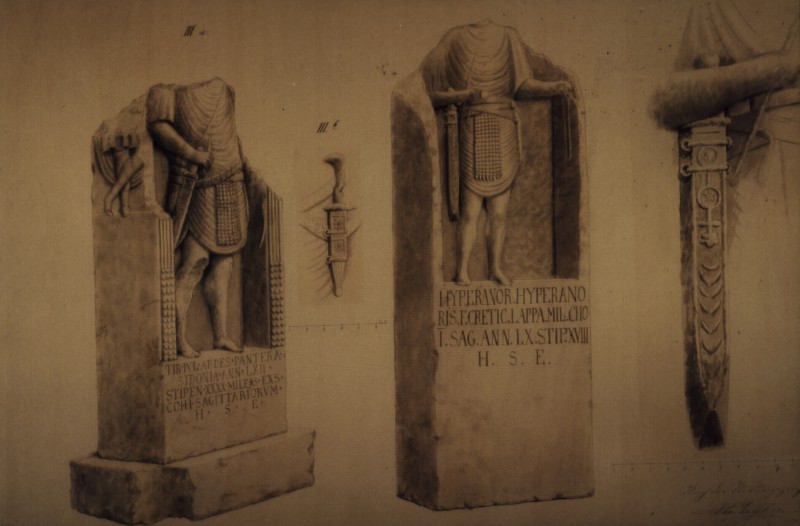
Figure
1. Roman tombstones in Bingerbrück, Germany. That of Tiberius Julius
Abdes Pantera is shown on the left. Some scholars have used this example to show
that Jesus's Jewish title "son of the panther" arose from a belief that
his father was a Roman soldier stationed in Judaea.
Allegro's
Cult of the Mushroom
Another
person to realise the connection between the rights of Dionysus and early forms
Christianity was English archaeologist and Dead Dead Scroll scholar John M. Allegro.
In 1970 he wrote a challenging book entitled The Sacred Mushroom and the Cross,
which argues that the sacrament in various mystery cults from ancient Mesopotamia
down to the cult of Jesus was the hallucinogenic mushroom.
Having
acknowledged that the panther was a major totem of the god Bacchus-Dionysus he
explained how its use as a symbol of the religious rites carried out in the name
of the god was in fact a euphemism for the ingestion of magic mushrooms. Allegro
pointed out the clear similarity between the white spots on the red cap of the
fly agaric or fly amanita mushroom Amanita muscaria, which is extremely
psychoactive in nature. Another fly agaric species, the tawny brown-capped Amanita
pantherina, found mostly in southern Europe and Western Asia, is even known
as the "Panther Cap" (see figure 2).

Figure
2. Amanita pantherina, or "Panther Cap," which is
found in southern Europe and Western Asia. Note the leopard-like spots on its
cap. Picture credit: Wiki Commons Agreement, 2016.
Although
the Latin name Amanita pantherina only dates back to 1815 the connection
between the appearance of the mushroom and the two-tone coat of a panther is liable
to be much older. If correct then Allegro concluded that the connection between
the panther and the fly agaric or fly amanita mushrooms would have been known
in ancient times, hence the use of the panther as a euphemism for the use of the
sacred mushroom during Dionysian rites.
Allegro himself informs his reader that in Jewish Talmudic tradition Jesus bore the epithet Bar Pandera, "son of the panther." More incredible, he said, is that the zealous actions of Christian censors managed to overlook the significance of Jesus's curious epithet, for if they had known its true Gnostic meaning it would have been eradicated at a very early date. For in the opinion of Allegro Bar Pandera was a reference to the fact, " … that the early Jews were well aware of the original mushroom nature of the Christian cult, even though, later, through persecution and the passage of time, this information was lost or, at least, no longer expressed in literary form."
As compelling as Allegro's theories on the importance of the sacred mushroom in Jewish and Christian-based Gnosticism might seem, he fell short of implying that Jesus was himself involved in any kind of pagan mystery cult. However, the appearance of the term "panther" or "son of the panther" in connection with Jesus's patriarchal line implies that there was real meaning behind this obviously derogatory title given to him by the Jews. Perhaps members of his family, most obviously his grandfather Jacob or father Joseph, were themselves involved in some kind of Dionysian mystery cult in which the symbol of the panther featured as a symbol of initiation and transformation(the panther was the primary animistic form of the god Bacchus-Dionysus - see figure 3).
Orphic-Bacchic Origins
As Bacchus-Dionysus might himself have emerged from a much earlier cult figure associated with the Harranian god Bar Nemre, the "son of the panther," these ideas concerning the Orphic-Bacchic origins of Christianity should not be dismissed lightly. Moreover, it seems obvious that if Jesus and members of his family really were members of a pagan mystery cult then the most likely solution is that it can be identified with the cult of Bacchus-Dionysus. Indeed, it was almost certainly this association that had been recognized by the Jews who began mockingly implying that Jesus was Bar Pandera, the "son of the panther." Was this due to some hereditary role Jesus might have played within the cult, which is known to have thrived, for instance, in Jerusalem around the time of Christ?
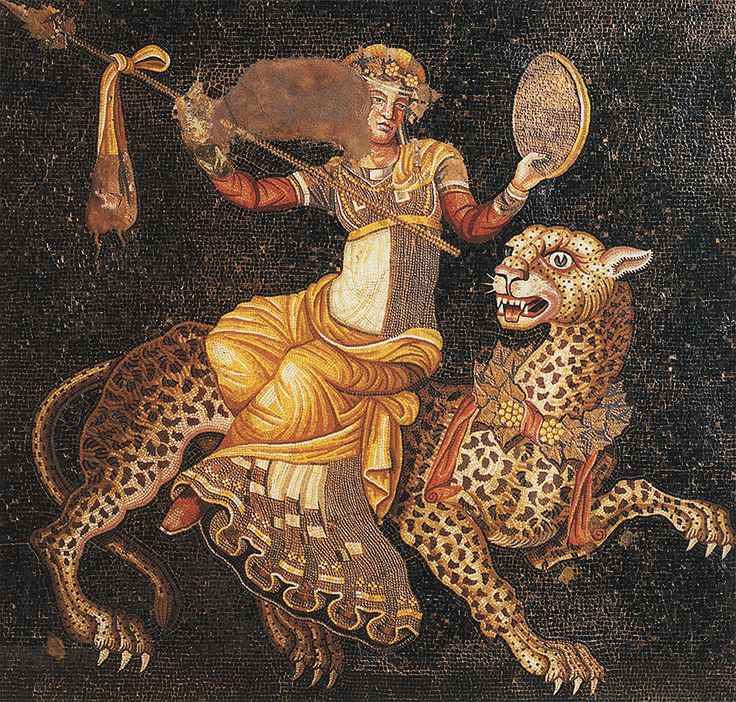
Figure
3. Bacchus-Dionysus riding the leopard, his primary animistic form, into which
he could transform at will.
The
cult of Bacchus-Dionysus was linked also with that of Orpheus. He was said to
have descended into the underworld in pursuit of his kidnapped wife Eurydice,
and afterwards returned to the land of the living to tell the tragic tale. Not
only did Orpheus's enchanting music, played on his famous lyre, mesmerize all
who heard it, but its charm had also been able to secure Eurydice's release from
the underworld, even though he failed to rescue her in the famous story of how
he ignored the warnings of the underworld gods about looking back towards her
as she departed Hades, causing her to be dragged back down to hell for all eternity.
Following his brutal death at the hands of the Maenads, Orpheus's lyre was placed in the sky as the constellation that bears its name, Lyra. Orpheus himself was transformed by Zeus into a swan and placed next his lyre as the constellation of Cygnus. Like Bacchus-Dionysus Orpheus was also linked to the symbol of the leopard. For instance, his garments bore the spots of the animal (see figure 4). Interestingly in Babylonian astronomy the stars of Cygnus and the neighbouring constellation of Cepheus were combined to form a sky-panther or griffin known as UD.KA.DUH.A, which means "demon with gaping mouth." This supernatural creature is thought to have guarded the entrance to the realm of the dead. In Akkadian it was known more simply as Nimru, meaning "panther."
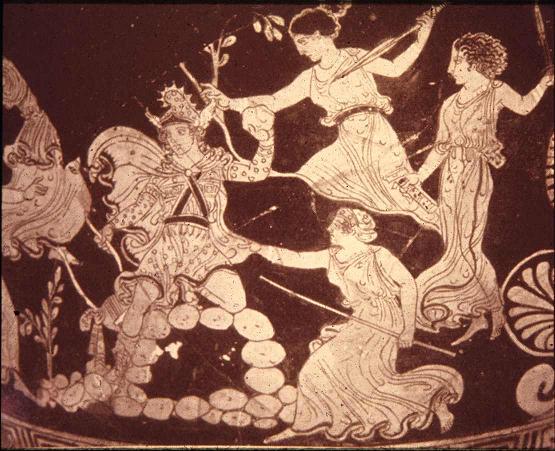
Figure
4. Orpheus being torn limb from limb by Maenads, the frenzied devotees of
Bacchus-Dionysus. Note the leopard spots on his garments, showing his own affiliation
with the animal. In death, Orpheus was changed into a swan that was placed in
the heavens (the constellation of Cygnus) next to his beloved lyre (the constellation
of Lyra). From a Greek vase.
Cygnus has been known as the Northern Cross, the Cross of Calvary, or the Cross of St Helen, since at least the sixth century CE (see figure 5). Arguably, its personification as a cross of crucifixion derived from much earlier pagan sources. For instance, a Greco-Roman hematite magical gem of the mid-third century, housed until it went missing during the Second World War in the Kaiser-Friedrich Museum, Berlin, shows a figure, knees together and bent to one side, upon a crucifixion cross. Indeed, it might easily be mistaken for a representation of Christ were it not for its Greek inscription written across the face of the gem. This reads: Orpheus Bakkikos ("Bacchic Orpheus"), an allusion to Orpheus as an incarnation of Bacchus-Dionysus and founder of the Orphic mysteries (see figure 6).
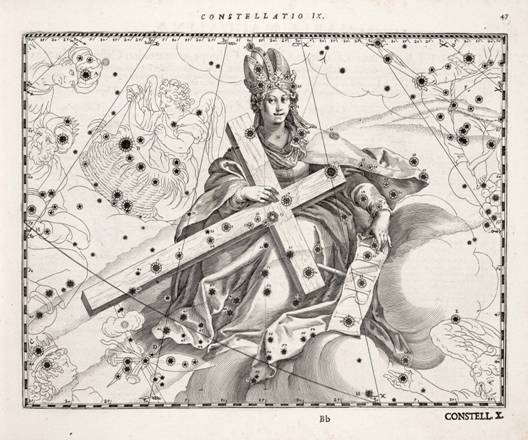
Figure
5. Cygnus, or the Northern Cross, as the True Cross, or St Helen's Cross.
Before the Calvary Cross became Christianity's primary symbol of death and resurrection, it was clearly not Jesus who was depicted on the cross of crucifixion, but Orpheus-Bacchus. What is more, the existence of the Orpheus-Bacchus gem adds weight to the belief that at the core of Christianity is a real link between the Orphite-Bacchic teachings on the transmigration of the soul and its destination among the stars. Was this location marked in the night sky by the stars representing the "Bacchic Orpheus," the precursor to Jesus Christ in his role as god of death and resurrection (the story of Christ as the Good Shepherd was also influenced by Orpheus's ability to charm the animals and birds through the playing of his lyre)? Was that afterlife reached following judgment at what was known in Orphite tradition as the "Dividing Road," which is almost certainly to be identified with the fork or cleft in the Milky Way formed by the so-called Dark Rift, or Cygnus Rift, a dark region of stellar dust and debris in line with the axis of the galactic plane? Is the Bacchic Orpheus in actuality a reference to Orpheus in his role as the Cygnus constellation?
There seems little question that the pagan mystery cult of Orpheus-Bacchus, as well as that of Bacchus-Dionysus, inspired key elements of the Jesus cult that had its genesis in Judaea following the death of its founder in the first century AD. Moreover, from the evidence presented here it seems clear that the origins of Christianity might well have had age-old ecstatic roots (as John Allegro realised). These focused around the symbol of the leopard in its role as an animistic totem adopted by the shaman during altered states of consciousness in order to enter the realm of the dead. Through these links the connection with Cygnus in its role as UD.KA.DUH.A, the panther-griffin of Babylonian tradition that guarded the entrance to the underworld, begins to make sense. For there is now compelling evidence that Cygnus might well have been the original destination of the soul not only in Orphic-Bacchic tradition, but also in very early forms of Christianity that later recognised the constellation as the Cross of Calvary, the ultimate symbol today of death and resurrection for Christians the world over.
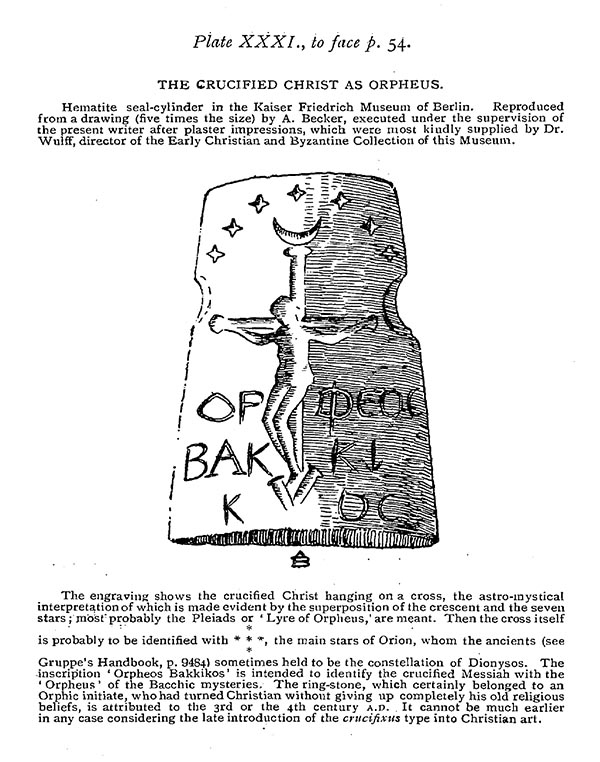
Figure
6. Greco-Roman gem in hematite from the mid-third century AD showing the figure
of Orpheus-Bacchus on a Christian style Calvary Cross. Without the Greek inscription
the crucified figure shown on the gem would have been identified as Christ crucified.
Despite the caption to the line drawing reproduced here, which suggests that the
stars on the gem should be attributed to the constellation of Orion, there is
little question they represent seven key stars of Cygnus in its role as the Northern
Cross or Cross of Calvary, a role it has played since at least the sixth century
AD. The gem itself was lost during World War II, and despite claims it is a forgery,
the item remains a true historical enigma, which challenges our understanding
of the development of the Christian Crucifix design.
For
more on these matters see
Andrew Collins's book The
Cygnus Mystery (2006)